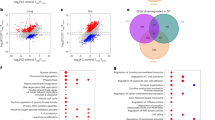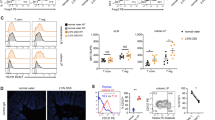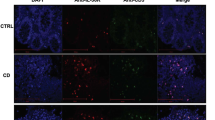Abstract
The molecular checkpoints that drive inflammatory bowel diseases are incompletely understood. Here we found more T cells expressing the transcription factor PU.1 and interleukin 9 (IL-9) in patients with ulcerative colitis. In an animal model, citrine reporter mice had more IL-9-expressing mucosal T cells in experimental oxazolone-induced colitis. IL-9 deficiency suppressed acute and chronic colitis. Mice with PU.1 deficiency in T cells were protected from colitis, whereas treatment with antibody to IL-9 suppressed colitis. Functionally, IL-9 impaired intestinal barrier function and prevented mucosal wound healing in vivo. Thus, our findings suggest that the TH9 subset of helper T cells serves an important role in driving ulcerative colitis by regulating intestinal epithelial cells and that TH9 cells represent a likely _target for the treatment of chronic intestinal inflammation.
This is a preview of subscription content, access via your institution
Access options
Subscribe to this journal
Receive 12 print issues and online access
We are sorry, but there is no personal subscription option available for your country.
Buy this article
- Purchase on SpringerLink
- Instant access to full article PDF
Prices may be subject to local taxes which are calculated during checkout








Similar content being viewed by others
References
Danese, S. New therapies for inflammatory bowel disease: from the bench to the bedside. Gut 61, 918–932 (2012).
Strober, W., Fuss, I. & Mannon, P. The fundamental basis of inflammatory bowel disease. J. Clin. Invest. 117, 514–521 (2007).
Macdonald, T.T. & Monteleone, G. Immunity, inflammation, and allergy in the gut. Science 307, 1920–1925 (2005).
Danese, S. & Fiocchi, C. Ulcerative colitis. N. Engl. J. Med. 365, 1713–1725 (2011).
Neurath, M.F., Finotto, S. & Glimcher, L.H. The role of Th1/Th2 polarization in mucosal immunity. Nat. Med. 8, 567–573 (2002).
Neurath, M.F. et al. The transcription factor T-bet regulates mucosal T cell activation in experimental colitis and Crohn's disease. J. Exp. Med. 195, 1129–1143 (2002).
Fuss, I.J. et al. Disparate CD4+ lamina propria (LP) lymphokine secretion profiles in inflammatory bowel disease. Crohn's disease LP cells manifest increased secretion of IFN-gamma, whereas ulcerative colitis LP cells manifest increased secretion of IL-5. J. Immunol. 157, 1261–1270 (1996).
Fuss, I.J. & Strober, W. The role of IL-13 and NK T cells in experimental and human ulcerative colitis. Mucosal Immunol. 1 (suppl. 1), S31–S33 (2008).
Kobayashi, T. et al. IL23 differentially regulates the Th1/Th17 balance in ulcerative colitis and Crohn's disease. Gut 57, 1682–1689 (2008).
Kleinschek, M.A. et al. Circulating and gut-resident human Th17 cells express CD161 and promote intestinal inflammation. J. Exp. Med. 206, 525–534 (2009).
Ono, Y. et al. T-helper 17 and interleukin-17-producing lymphoid tissue inducer-like cells make different contributions to colitis in mice. Gastroenterology 143, 1288–1297 (2012).
Ahern, P.P. et al. Interleukin-23 drives intestinal inflammation through direct activity on T cells. Immunity 33, 279–288 (2010).
Leppkes, M. et al. RORγ-expressing Th17 cells induce murine chronic intestinal inflammation via redundant effects of IL-17A and IL-17F. Gastroenterology 136, 257–267 (2009).
Heller, F., Fuss, I.J., Nieuwenhuis, E.E., Blumberg, R.S. & Strober, W. Oxazolone colitis, a Th2 colitis model resembling ulcerative colitis, is mediated by IL-13-producing NK-T cells. Immunity 17, 629–638 (2002).
Dardalhon, V. et al. IL-4 inhibits TGF-β-induced Foxp3+ T cells and, together with TGF-β, generates IL-9+IL-10+Foxp3− effector T cells. Nat. Immunol. 9, 1347–1355 (2008).
Veldhoen, M. et al. Transforming growth factor-β 'reprograms' the differentiation of T helper 2 cells and promotes an interleukin 9-producing subset. Nat. Immunol. 9, 1341–1346 (2008).
Gessner, A., Blum, H. & Rollinghoff, M. Differential regulation of IL-9-expression after infection with Leishmania major in susceptible and resistant mice. Immunobiology 189, 419–435 (1993).
Licona-Limón, P. et al. Th9 cells drive host immunity against gastrointestinal worm infection. Immunity 39, 744–757 (2013).
Wilhelm, C. et al. An IL-9 fate reporter demonstrates the induction of an innate IL-9 response in lung inflammation. Nat. Immunol. 12, 1071–1077 (2011).
Turner, J.E. et al. IL-9-mediated survival of type 2 innate lymphoid cells promotes damage control in helminth-induced lung inflammation. J. Exp. Med. 210, 2951–2965 (2013).
Angkasekwinai, P., Chang, S.H., Thapa, M., Watarai, H. & Dong, C. Regulation of IL-9 expression by IL-25 signaling. Nat. Immunol. 11, 250–256 (2010).
Chang, H.C. et al. The transcription factor PU.1 is required for the development of IL-9-producing T cells and allergic inflammation. Nat. Immunol. 11, 527–534 (2010).
Staudt, V. et al. Interferon-regulatory factor 4 is essential for the developmental program of T helper 9 cells. Immunity 33, 192–202 (2010).
Jabeen, R. et al. Th9 cell development requires a BATF-regulated transcriptional network. J. Clin. Invest. 123, 4641–4653 (2013).
Goswami, R. & Kaplan, M.H. Gcn5 is required for PU.1-dependent IL-9 induction in Th9 cells. J. Immunol. 189, 3026–3033 (2012).
Temann, U.A., Ray, P. & Flavell, R.A. Pulmonary overexpression of IL-9 induces Th2 cytokine expression, leading to immune pathology. J. Clin. Invest. 109, 29–39 (2002).
Jabeen, R. & Kaplan, M.H. The symphony of the ninth: the development and function of Th9 cells. Curr. Opin. Immunol. 24, 303–307 (2012).
Devos, S. et al. Allergen-induced interleukin-9 production in vitro: correlation with atopy in human adults and comparison with interleukin-5 and interleukin-13. Clin. Exp. Allergy 36, 174–182 (2006).
Schulzke, J.D. et al. Epithelial tight junctions in intestinal inflammation. Ann. NY Acad. Sci. 1165, 294–300 (2009).
Lejeune, D., Demoulin, J.B. & Renauld, J.C. Interleukin 9 induces expression of three cytokine signal inhibitors: cytokine-inducible SH2-containing protein, suppressor of cytokine signalling (SOCS)-2 and SOCS-3, but only SOCS-3 overexpression suppresses interleukin 9 signalling. Biochem. J. 353, 109–116 (2001).
Kaplan, M.H. Th9 cells: differentiation and disease. Immunol. Rev. 252, 104–115 (2013).
Blom, L., Poulsen, B.C., Jensen, B.M., Hansen, A. & Poulsen, L.K. IL-33 induces IL-9 production in human CD4+ T cells and basophils. PLoS ONE 6, e21695 (2011).
Uyttenhove, C., Brombacher, F. & Van Snick, J. TGF-beta interactions with IL-1 family members trigger IL-4-independent IL-9 production by mouse CD4+ T cells. Eur. J. Immunol. 40, 2230–2235 (2010).
Townsend, J.M. et al. IL-9-deficient mice establish fundamental roles for IL-9 in pulmonary mastocytosis and goblet cell hyperplasia but not T cell development. Immunity 13, 573–583 (2000).
Zhou, M. & Ouyang, W. The function role of GATA-3 in Th1 and Th2 differentiation. Immunol. Res. 28, 25–37 (2003).
Moussata, D. et al. Confocal laser endomicroscopy is a new imaging modality for recognition of intramucosal bacteria in inflammatory bowel disease in vivo. Gut 60, 26–33 (2011).
Sato, T. & Clevers, H. Growing self-organizing mini-guts from a single intestinal stem cell: mechanism and applications. Science 340, 1190–1194 (2013).
Pickert, G. et al. STAT3 links IL-22 signaling in intestinal epithelial cells to mucosal wound healing. J. Exp. Med. 206, 1465–1472 (2009).
Monteleone, I., Sarra, M., Pallone, F. & Monteleone, G. Th17-related cytokines in inflammatory bowel diseases: friends or foes? Curr. Mol. Med. 12, 592–597 (2012).
Mudter, J. et al. The transcription factor IFN regulatory factor-4 controls experimental colitis in mice via T cell-derived IL-6. J. Clin. Invest. 118, 2415–2426 (2008).
Pastorelli, L. et al. Epithelial-derived IL-33 and its receptor ST2 are dysregulated in ulcerative colitis and in experimental Th1/Th2 driven enteritis. Proc. Natl. Acad. Sci. USA 107, 8017–8022 (2010).
Kobori, A. et al. Interleukin-33 expression is specifically enhanced in inflamed mucosa of ulcerative colitis. J. Gastroenterol. 45, 999–1007 (2010).
Elyaman, W. et al. IL-9 induces differentiation of TH17 cells and enhances function of FoxP3+ natural regulatory T cells. Proc. Natl. Acad. Sci. USA 106, 12885–12890 (2009).
Forbes, E.E. et al. IL-9- and mast cell-mediated intestinal permeability predisposes to oral antigen hypersensitivity. J. Exp. Med. 205, 897–913 (2008).
Heller, F. et al. Interleukin-13 is the key effector Th2 cytokine in ulcerative colitis that affects epithelial tight junctions, apoptosis, and cell restitution. Gastroenterology 129, 550–564 (2005).
Kim, H.S. & Chung, D.H. IL-9-producing invariant NKT cells protect against DSS-induced colitis in an IL-4-dependent manner. Mucosal Immunol. 6, 347–357 (2013).
Hardman, C.S., Panova, V. & McKenzie, A.N. IL-33 citrine reporter mice reveal the temporal and spatial expression of IL-33 during allergic lung inflammation. Eur. J. Immunol. 43, 488–498 (2013).
Kulkarni, M.S. & Yielding, K.L. DNA damage and repair in epithelial (mucous) cells and crypt cells from isolated colon. Chem. Biol. Interact. 52, 311–318 (1985).
Nguyen, H.T. et al. CD98 expression modulates intestinal homeostasis, inflammation, and colitis-associated cancer in mice. J. Clin. Invest. 121, 1733–1747 (2011).
Wong, S.H. et al. Transcription factor RORα is critical for nuocyte development. Nat. Immunol. 13, 229–236 (2012).
Acknowledgements
Supported by the Clinical Research Group CEDER of the German Research Council (B.W., R.A. and M.F.N.), Deutsche Forschungsgemeinschaft (WE 4656/1-1 for support of B.W., R.A. and M.F.N.), Interdisziplinares Zentrum fur Klinische Forschung (B.W., R.A. and M.F.N.), the Emerging Field Initiative (B.W., R.A. and M.F.N.), the ELAN programs of the University Erlangen-Nürnberg (B.W., R.A. and M.F.N.), Deutsche Forschungsgemeinschaft Collaborative Research Centers 643 and 796 (H.D., S.W. and M.F.N.), the American Asthma Foundation, the UK Medical Research Council, the Wellcome Trust (100963 to A.N.J.M.) and the Agency for Science Technology and Research (Y.Y.H.).
Author information
Authors and Affiliations
Contributions
K.G. did experiments together with Y.Y.H., A.N., S.S. and B.W.; R.A., H.D., S.W., F.R., A.N.J.M., B.W. and M.F.N. provided clinical samples, protocols or mice or designed experiments; K.G., Y.Y.H., A.N., S.S., H.-A.L., M.V., A.N.J.M. and B.W. analyzed data; K.G., H.-A.L., A.W., F.R., A.N.J.M., B.W. and M.F.N. discussed and interpreted findings; and K.G., Y.Y.H., B.W. and M.F.N. wrote the manuscript.
Corresponding author
Ethics declarations
Competing interests
The authors declare no competing financial interests.
Integrated supplementary information
Supplementary Figure 1 Analysis of claudin expression in human colonic samples
Total mRNA was isolated from 24-35 human samples of human control tissue or IBD tissue. Expression of PIAS1, SOCS3, CLDN1 and CLDN2 mRNA in human colonic tissue of IBD patients was analyzed. SOCS3 and CLDN2 mRNA levels were up regulated in active UC patient samples. Significant differences are indicated.
Supplementary Figure 2 Generation and analysis of IL-9–citrine reporter mice
(a) Generation of II9Cit reporter mice. The _targeting strategy to insert the citrine reporter gene at the start codon of the II9 gene is shown. neo, neomycin cassette; TK, thymidine kinase cassette; e1, II9 exon 1. The black rectangle represents the 5' probe for Southern blot screening. (b) Southern hybridization for II9Cit-_targeted clones. A positive colony of an II9Cit embryonic stem cell clone using the 5' probe is shown. Wild-type allele, 7.0 kb; _targeted allele, 6.0 kb. (c) Detection of II9 in CD4+ T cells differentiated in vitro using citrine reporter (citrine - top panels) or intracellular staining (ICS – lower panels). Before FACS analysis CD4+ T cells were purified from naïve spleen cells and plated under the following conditions for 72 hours. TH0: plate bound anti-CD3 and anti-CD28 antibodies. TH1: plate bound anti-CD3 antibodies, anti-CD28 antibodies, IL2, IL12, anti-IL4 antibodies. TH2: plate bound anti-CD3 antibodies, anti-CD28 antibodies, IL2, IL4, anti-IFN-γ antibodies. TH9: plate bound anti-CD3 antibodies, anti-CD28 antibodies, IL4, TGF-β. (d) Detection of II9Cit and IL9 ICS in mice following rIL33 administration. Mice were treated with three daily doses of IL33. Mesenteric lymph nodes (MLN) were harvested and cells were analyzed for citrine expression or IL9 ICS. Representative of three biological replicates are shown. (e) Detection of Il9Cit following Nippostrongylus brasiliensis infection. Six days post-infection MLN were harvested and analyzed for citrine expression. Only ILC2 in the mesenteric lymph nodes on day 6 expressed citrine. T cells and other cell types in other organs and other time points did not express detectable citrine at this time point (not shown). Representative images of three biological replicates are shown.
Supplementary Figure 3 IL33 induces IL9 production
Quantitative RT-PCR analysis of mucosal II33 mRNA levels in murine oxazolone-induced colitis and normal colon (n= 22). Relative expression of II33 was normalized to the house keeping gene 18sRNA. Significant differences are indicated (left panel). Spleens were taken from seven animals. Isolated murine spleen CD4+ T cells were stimulated with different cytokines to analyze IL9 production. Supernatants were taken after 48 hours and analyzed for IL9 content by ELISA. Significant differences are indicated (middle panel). Isolated T cell-enriched lamina propria cells from seven wild-type mice were stimulated with different cytokines and IL9 production was analyzed in the supernatant after 48h by ELISA (right panel). A second independent experiment gave similar results. FACS analysis for expression of cytokine receptors was performed in splenic and lamina propria CD3+ T cells. Representative stainings from three independent experiments are shown (lower panel).
Supplementary Figure 4 TH9 transcription factor analysis in wild-type and IL-9-deficient mice
(a) Expression of pro-inflammatory cytokines was analyzed using quantitative RT-PCR. Total mRNA was isolated from the inflamed colon of wild-type and II9-deficient mice (n= 8-21) followed by qPCR analysis. Data were normalized to the house keeping gene 18sRNA. Significant differences are indicated. (b) Expression of T cell transcription factors was analyzed using quantitative RT-PCR. Data were normalized to the house keeping gene 18sRNA. Levels of Gata3, Irf4, Tbet, Foxp3, Rorγt and Spi1 were analyzed in II9 knockout mice as compared to wild-type animals (n= 14-18). (c) Immunofluorescence staining of PU.1 was performed on cryosections from colonic tissue of wildtype and II9 knockout mice. Cell nuclei were counterstained with HOECHST dye. Representative stainings are shown. In addition, double staining with CD4 was performed and significant changes are indicated.
Supplementary Figure 5 A role for IL9 in adoptive T cell transfer
Syngenic SCID mice were reconstituted with wild-type or II9-deficient T cells followed by analysis of colitis activity. High resolution endoscopy was performed at day 42 to analyze colitis activity (n=9). Representative histological pictures at the end of the experiment are shown as well as histological scoring of colitis activity. Significant differences are indicated. In addition, representative stainings of in vivo imaging with IVIS analysis are shown. Data are representative of two independent experiments.
Supplementary information
Supplementary Text and Figures
Supplementary Figures 1–5 and Supplementary Table 1 (PDF 769 kb)
Rights and permissions
About this article
Cite this article
Gerlach, K., Hwang, Y., Nikolaev, A. et al. TH9 cells that express the transcription factor PU.1 drive T cell–mediated colitis via IL-9 receptor signaling in intestinal epithelial cells. Nat Immunol 15, 676–686 (2014). https://doi.org/10.1038/ni.2920
Received:
Accepted:
Published:
Issue Date:
DOI: https://doi.org/10.1038/ni.2920



